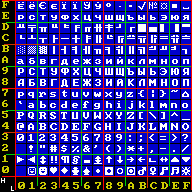Related Research Articles

Code page 855 is a code page used under DOS to write Cyrillic script.

Code page 866 is a code page used under DOS and OS/2 in Russia to write Cyrillic script. It is based on the "alternative code page" developed in 1984 in IHNA AS USSR and published in 1986 by a research group at the Academy of Science of the USSR. The code page was widely used during the DOS era because it preserves all of the pseudographic symbols of code page 437 and maintains alphabetic order of Cyrillic letters. Initially this encoding was only available in the Russian version of MS-DOS 4.01 (1990), but with MS-DOS 6.22 it became available in any language version.
Code page 852 is a code page used under DOS to write Central European languages that use Latin script.
Code page 865 is a code page used under DOS in Denmark and Norway to write Nordic languages.
Code page 860 is a code page used under DOS in Portugal to write Portuguese and it is also suitable to write Spanish and Italian. In Brazil, however, the most widespread codepage – and that which DOS in Brazilian Portuguese used by default – was code page 850.
Code page 863 is a code page used under DOS in Canada to write French although it lacks the letters Æ, æ, Œ, œ, Ÿ and ÿ.
Code page 857 is a code page used under DOS in Turkey to write Turkish.

Code page 737 is a code page used under DOS to write the Greek language. It was much more popular than code page 869 although it lacks the letters ΐ and ΰ.
Code page 861 is a code page used under DOS in Iceland to write the Icelandic language.
Code page 720 is a code page used under DOS to write Arabic in Egypt, Iraq, Jordan, Saudi Arabia, and Syria. The Windows (ANSI) code page for Arabic is Windows-1256.
MacGreek encoding or Macintosh Greek encoding is used in Apple Macintosh computers to represent texts in the Greek language that uses the Greek script. This encoding is registered as IBM code page/CCSID 1280 and Windows code page 10006.
Code page 915 is a code page used under IBM AIX and DOS to write the Bulgarian, Belarusian, Russian, Serbian and Macedonian but was never widely used. It would also have been usable for Ukrainian in the Soviet Union from 1933 to 1990, but it is missing the Ukrainian letter ge, ґ, which is required in Ukrainian orthography before and since, and during that period outside Soviet Ukraine. As a result, IBM created Code page 1124. It is an extension of ISO/IEC 8859-5. The original code page matched ISO/IEC 8859-5 directly.
Code page 853 is a code page used under DOS to write Turkish, Maltese, and Esperanto. It includes all characters from ISO 8859-3.
Code page 856, is a code page used under DOS for Hebrew in Israel.
Each character is shown with its equivalent Unicode code point. Only the second half of the table is shown, the first half being the same as ASCII.
Code page 868 is a code page used to write Urdu in Pakistan.
Code page 896, called Japan 7-Bit Katakana Extended, is IBM's code page for code-set G2 of EUC-JP, a 7-bit code page representing the Kana set of JIS X 0201 and accompanying Code page 895 which corresponds to the lower half of that standard. It encodes half-width katakana.
Code page 1098 (also known as CP 1098, IBM 01098, is a code page used to write Persian in Iran.
Code page 921 is a code page used under IBM AIX and DOS to write the Estonian, Latvian, and Lithuanian languages. It is an extension of ISO/IEC 8859-13. The original code page matched ISO/IEC 8859-13 directly.
Code page 1115, also known as Simplified Chinese PC Data, is a single byte character set (SBCS) used by IBM in its PC DOS operating system in China.
References
- ↑ "CCSID 859 information document". Archived from the original on 2016-03-27.
- ↑ "Code page 859 information document". Archived from the original on 2016-03-03.
- ↑ Code Page CPGID 00859 (pdf) (PDF), IBM
- ↑ Code Page CPGID 00859 (txt), IBM